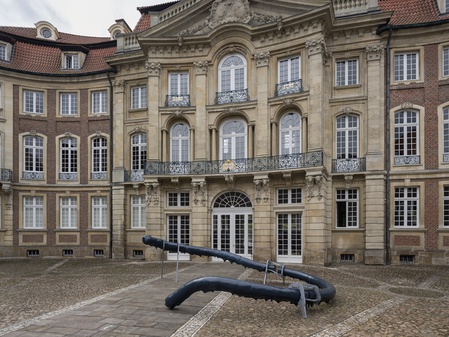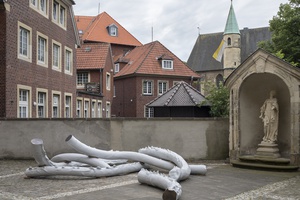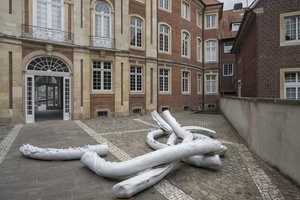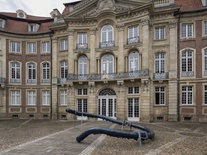Nairy Baghramian
Beliebte Stellen / Privileged Points
2017
Sculpture
Lacquered bronze, metal, lashing chain, tensioning devices, rubber
Location
Front and rear courtyard of Erbdrostenhof, Salzstraße 38
Temporary installation for the duration of the exhibition.
Nairy Baghramian
* 1971 Isfahan, Iran, lives in Berlin, Germany
Nairy Bagrahmian brings together objects and sculptures that can be assigned to different sculptural genres. Their aesthetic vocabulary incorporates fragile objects that seem as if they were shaped by a flick of the wrist or a sketching gesture as well as works that resemble prosthetics, supports, parapets, and cushions. Although Baghramian always precisely alludes to the architectural, historical, and institutional framing of the specific exhibition environment, her works possess a conceptual mutability and adaptability that the artist consciously exploits. In this way, certain groups of works are deployed more frequently and recharged with further narratives.
Baghramian chose one of the top locations in Münster for her work Beliebte Stellen / Privileged Points: the Erbdrostenhof (a baroque palace built by Johann Conrad Schlaun in 1757). In the palace forecourt she placed an elegantly curved bronze landmark, consisting of three slender but heavy, interconnecting elements. They were held together by visible clamps and propped up in a few spots on the courtyard’s cobblestones. The open circle, measuring a diameter of approximately five metres, was explicitly interrupted by the dimensions of the objects, whose bronze casting makes for an optimal result. In the palace’s rear courtyard (which can be accessed from the St Servatii church square), six similar sculpture elements were piled up that could be used to assemble two more Beliebte Stellen / Privileged Points.
By choosing this particular location, the artist deliberately followed the tradition of sculptural positions by artists like Richard Serra (Trunk: Johann Conrad Schlaun Recomposed, 1987) and Andreas Siekmann (Trickle Down: Der öffentliche Raum im Zeitalter seiner Privatisierung, 2007) who left their mark on the same location — thirty and ten years ago respectively, both as contributions to the Skulptur Projekte. With her work, Baghramian anticipated the cultural-political before and after as well as the professed site-specificity of the previous sculptures located here, which played a key role, especially with regard to Serra’s work. Not before the end of the exhibition, provided that the work has been sold, the separate elements of the sculpture — which is initially provisional and only finished with a primer — would actually be welded together and the work would be completed. Baghramian refered specifically to the history of art at this location, but she didn’t consciously impose any site-specific restrictions that would exclude the possibility of installing the work in another urban context or as part of a collection. She was one step ahead of the debates and the decision regarding the fate of her sculpture in Münster — they represented an immanent part of her work.
Nicola Torke
Images
Location
- Still existing / Public Collection
- Removed
- In the museum
Other Participation
This artist also participated in: 2007



